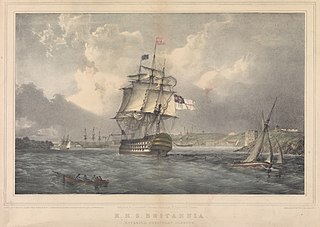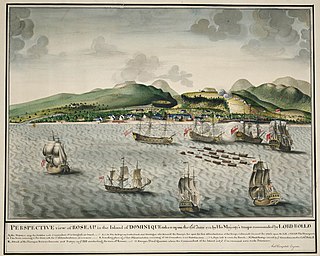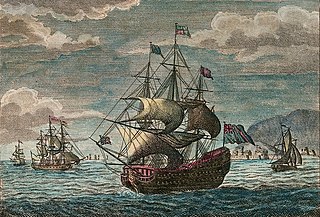
HMS Britannia was a 100-gun first-rate ship of the line of the Royal Navy. The vessel was laid down in 1751 and launched in 1762. Nicknamed Old Ironsides, she served in the American Revolutionary War, the French Revolutionary Wars and the Napoleonic Wars, including at the Battle of Trafalgar in 1805. One of the largest Royal Navy warships of her era, Britannia was one of only three British first-rates present at the battle, alongside HMS Victory and HMS Royal Sovereign. In 1806, the vessel was laid up and eventually converted into a hulk, before being broken up in 1825.

HMS Berwick was a 74-gun Elizabeth-class third rate of the Royal Navy, launched at Portsmouth Dockyard on 18 April 1775, to a design by Sir Thomas Slade. She fought the French at the Battle of Ushant (1778) and the Dutch at the Battle of Dogger Bank (1781). The French captured her in the action of 8 March 1795 during the French Revolutionary Wars and she served with them with some success then and at the start of the Napoleonic Wars until the British recaptured her at the Battle of Trafalgar. Berwick sank shortly thereafter in a storm.
HMS Nymph was a 14-gun Swan-class sloop of the Royal Navy, built by Israel Pownoll and launched at Chatham Dockyard on 27 May 1778. She was accidentally burnt and sank in the British Virgin Islands in 1783.

HMS Ardent was a 64-gun third-rate ship of the line of the Royal Navy. She was built by contract at Blaydes Yard in Hull according to a design by Sir Thomas Slade, and launched on 13 August 1764 as the first ship of the Ardent-class. She had a somewhat turbulent career, being captured by the French in the action of 17 August 1779, and then re-captured by Britain in 1782.

HMS Raisonnable was a 64-gun third-rate ship of the line of the Royal Navy, named after the ship of the same name captured from the French in 1758. She was built at Chatham Dockyard, launched on 10 December 1768 and commissioned on 17 November 1770 under the command of Captain Maurice Suckling, Horatio Nelson's uncle. Raisonnable was built to the same lines as HMS Ardent, and was one of the seven ships forming the Ardent class of 1761. Raisonnable was the first ship in which Nelson served.

HMS Dublin was a 74-gun third rate ship of the line of the Royal Navy, built by Adam Hayes at Deptford Dockyard and launched on 6 May 1757.

HMS Alcide, the French and Italian version of "Alcides", another name for Heracles, was a 74-gun third-rate ship of the line of the Royal Navy, designed by Sir Thomas Slade and built by Adam Hayes at Deptford Dockyard being launched on 30 July 1779.

HMS St Albans was a 64-gun third rate ship of the line of the Royal Navy, launched on 12 September 1764 by Perry, Wells & Green at their Blackwall Yard, London.

HMS Europa was a 64-gun third rate ship of the line of the Royal Navy, launched on 21 April 1765 at Lepe, Hampshire. She was renamed HMS Europe in 1778, and spent the rest of her career under this name.

HMS Sultan was a 74-gun third rate ship of the line of the Royal Navy, launched on 23 December 1775 at Harwich. Built to take part in the American Revolutionary War, her departure was delayed due to a shortage of crew and it was 9 June 1778 before she finally sailed as part of a squadron led by Rear-Admiral John Byron. In September she was with Richard Howe's fleet, blockading the French in Boston and in 1779, transferred to the West Indies, where she took part in the Battle of Grenada that July. Almost a year later, on 20 June 1780, she was involved in a short action off the coast of the Dominican Republic with a superior French force.

The Intrepid-class ships of the line were a class of fifteen 64-gun third rates, designed for the Royal Navy by Sir John Williams. His design, approved on 18 December 1765, was slightly smaller than Sir Thomas Slade's contemporary Worcester-class design of the same year, against which it was evaluated competitively. Following the prototype, four more ships were ordered in 1767–69, and a further ten between 1771 and 1779.

HMS Monmouth was an Intrepid-class 64-gun third rate ship of the line of the Royal Navy, built by Israel Pownoll and launched on 18 April 1772 at Plymouth. Being relatively compact in relation to her gun power, she was affectionately known as the "Little Black Ship".

The Foudroyant was an 80-gun ship of the line of the French Navy. She was later captured and served in the Royal Navy as the Third Rate HMS Foudroyant.
HMS Burford was a 70-gun third rate ship of the line of the Royal Navy, built at Chatham Dockyard to the draught specified by the 1745 Establishment as amended in 1754, and launched in 1757.
Anthony James Pye Molloy was an officer of the Royal Navy. He served during the American War of Independence and the French Revolutionary Wars.

HMS Victory is a 104-gun first-rate wooden sailing ship of the line. With 247 years of service as of 2025, she is the world's oldest naval vessel still in commission. She was ordered for the Royal Navy in 1758, during the Seven Years' War and laid down in 1759. That year saw British victories at Quebec, Minden, Lagos and Quiberon Bay and these may have influenced the choice of name when it was selected in October the following year. In particular, the action in Quiberon Bay had a profound effect on the course of the war; severely weakening the French Navy and shifting its focus away from the sea. There was therefore no urgency to complete the ship and the signing of the Treaty of Paris in February 1763, meant that when Victory was finally floated out in 1765, she was placed in ordinary. Her construction had taken 6,000 trees, 90% of them oak.

Sir Charles Saxton, 1st Baronet was an officer of the Royal Navy who saw service during the War of the Austrian Succession, the Seven Years' War, the American War of Independence and the French Revolutionary and Napoleonic Wars, rising to the rank of captain.

HMS Amazon was a 32-gun fifth-rate frigate of the Royal Navy, armed with a main battery of twenty-six 12 pounders and launched at Rotherhithe shipyard in 1773. She was first commissioned in February 1776 for war in America where she took part in operations against New York. Returning to England in February 1779, Amazon underwent a refit before serving in the English Channel and North Sea. In April 1780, she sailed to the Leeward Islands where, in October, she was almost wrecked in a hurricane.

Rear Admiral Sir Digby Dent (1739–1817) was a Royal Navy commander.

HMS Scarborough was a 20-gun ship built in 1756 which served the Royal Navy until 1780. She had a crew of 160 men.


















